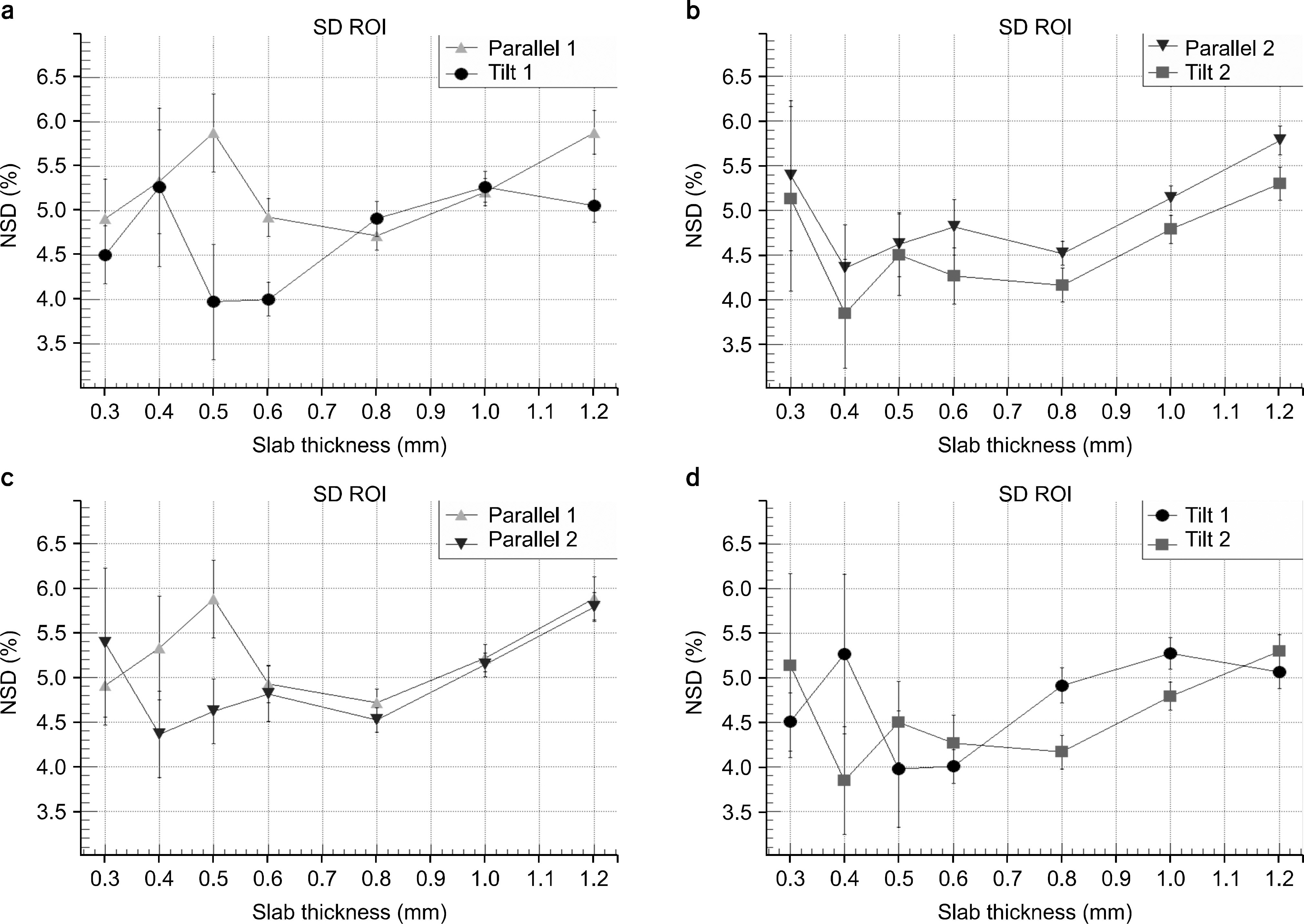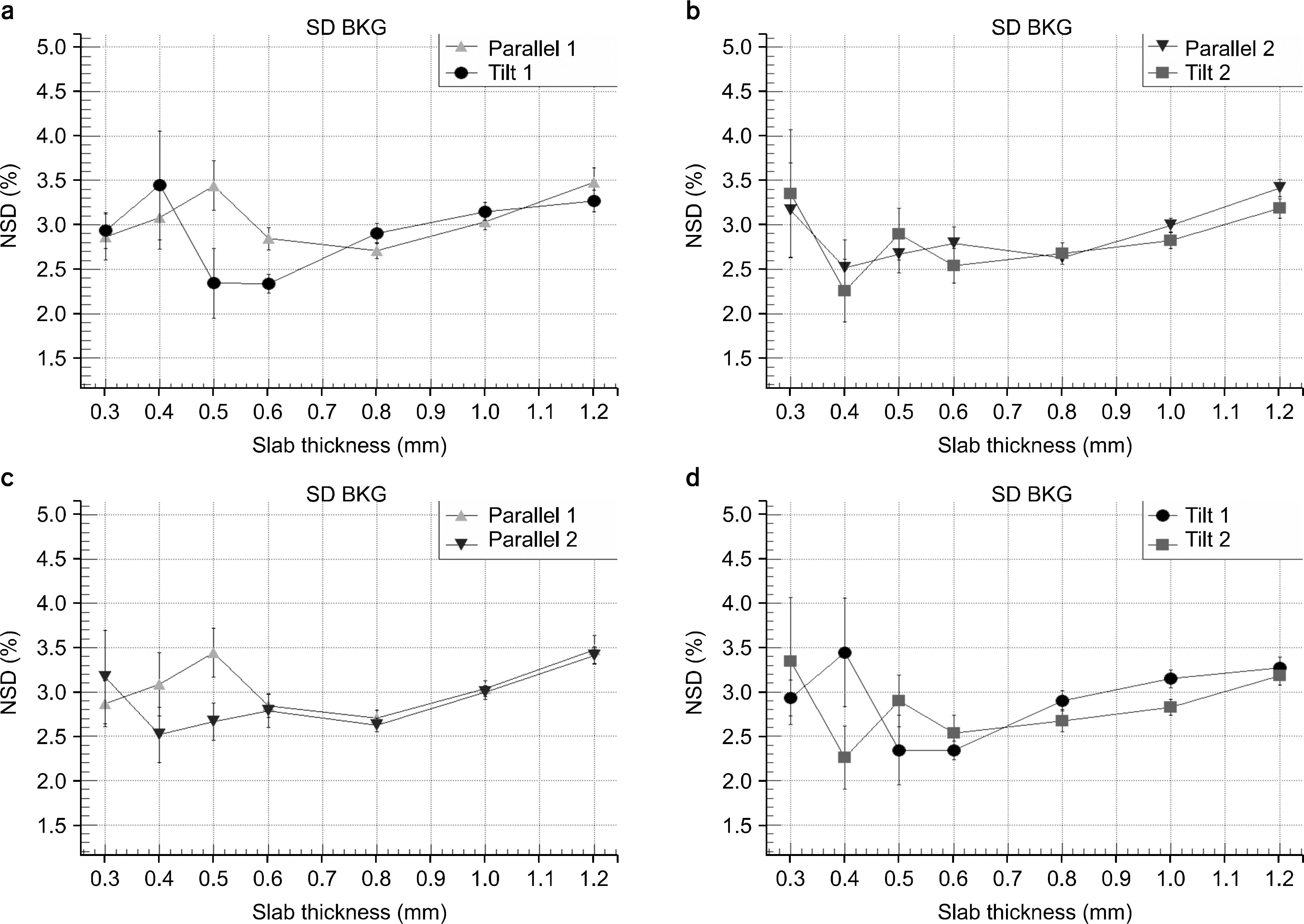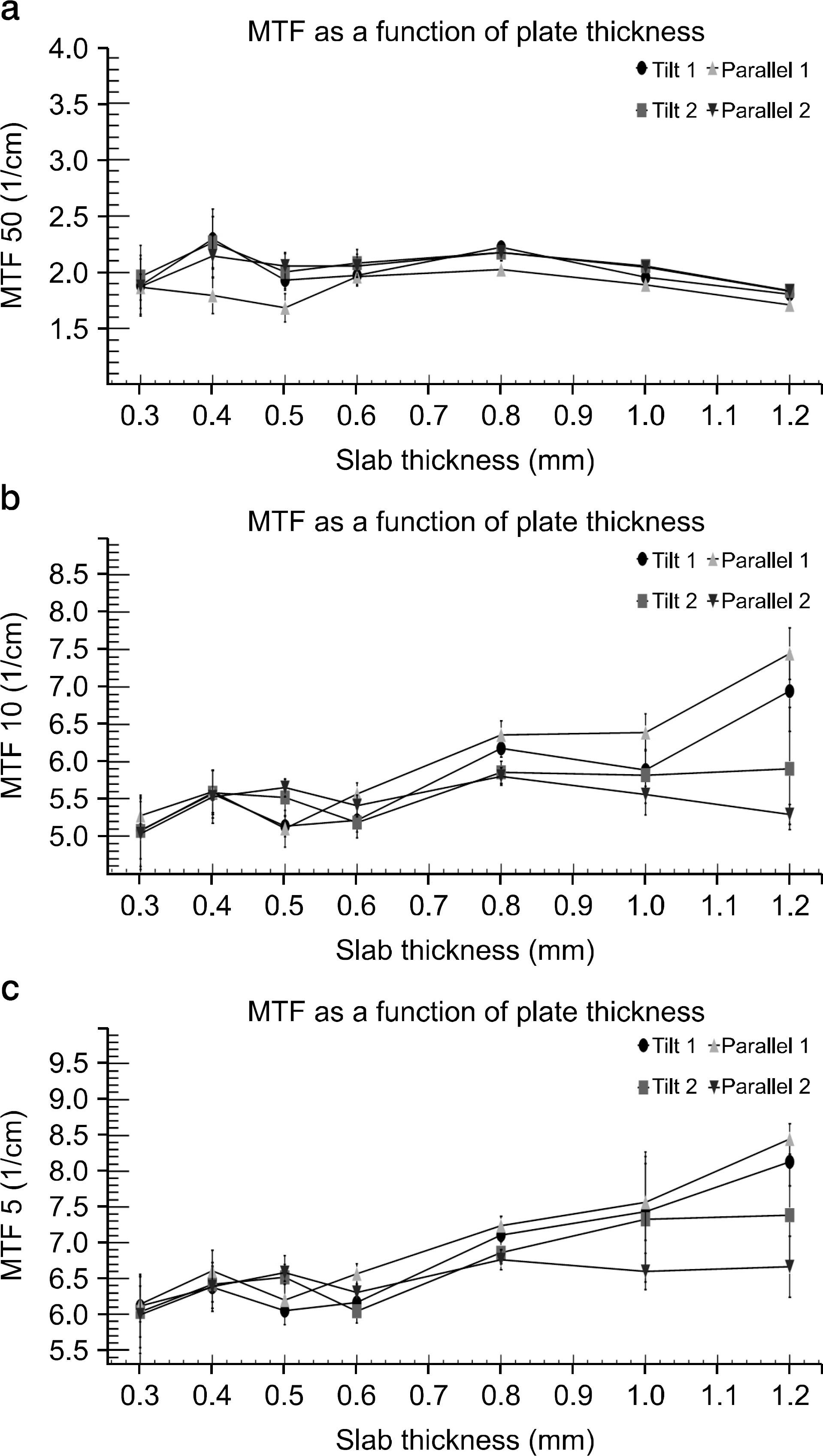Prog Med Phys.
2016 Jun;27(2):55-63. 10.14316/pmp.2016.27.2.55.
Modulation Transfer Function with Aluminum Sheets of Varying Thickness
- Affiliations
-
- 1Research Center, Dongnam Institute of Radiological and Medical Sciences, Busan, Korea. physics7@empas.com
- 2Department of Radiation Oncology, Dongnam Institute of Radiological and Medical Sciences, Busan, Korea.
- KMID: 2328189
- DOI: http://doi.org/10.14316/pmp.2016.27.2.55
Abstract
- We studied the method to gain a clear LSF using a thick aluminum sheet and to acquire the spatial resolution value with a high accuracy for a low spatial resolution imaging modality. In this study, aluminum sheets with thicknesses varying from 0.3 mm to 1.2 mm were tested to derive a modulation transfer function (MTF) for the oversampling and non-oversampling methods. The results were evaluated to verify the feasibility of the use of thick sheets for periodic quality assurance. Oversampling was more accurate than non-oversampling, and an aluminum sheet with a correction factor less than 2 at the cut-off frequency, which was less than 0.8 mm in this case, was confirmed to be suitable for MTF measurements. Therefore, MTF derivation from a thick aluminum sheet with thickness correction is plausible for a medical imaging modality.
MeSH Terms
Figure
Reference
-
References
1. Boone JM. Determination of the presampled MTF in computed tomography. Medical Physics. 28(3):356. 2001.
Article2. Garayoa J, Castro P. A study on image quality provided by a kilovoltage cone-beam computed tomography. J Appl Clin Med Phys. 14(1):3888. 2013.
Article3. Villafana T. Modulation transfer function of a finite scanning microdensitometer slit. Medical Physics. 2(5):251. 1975.
Article4. Gopal A, Samant SS. Use of a line-pair resolution phantom for comprehensive quality assurance of electronic portal imaging devices based on fundamental imaging metrics. Medical Physics. 36(6):2006. 2009.
Article5. Nickoloff EL. A simplified approach for modulation transfer function determinations in computed tomography. Medical Physics. 12(4):437. 1985.
Article6. Fujita H, Tsai DY, Itoh T, Morishita J, Ueda K, Ohtsuka A. A simple method for determining the modulation transfer function in digital radiography. IEEE Trans Med Imaging. 11(1):34–39. 1992.
Article7. Nakaya Y, Kawata Y, Niki N, Umetatni K, Ohmatsu H, Moriyama N. A method for determining the modulation transfer function from thick microwire profiles measured with x-ray microcomputed tomography. Medical Physics. 39(7):4347–4364. 2012.
Article8. Schwarzband G, Kiryati N. The point spread function of spi ral CT. Phys Med Biol. 50(22):5307–5322. 2005.9. Watanabe H, Honda E, Kurabayashi T. Modulation transfer function evaluation of cone beam computed tomography for dental use with the oversampling method. Dentomaxillofac Radiol. 39(1):28–32. 2010.
Article10. Yoo BG, Kweon DC, Lee JS. MTF Evaluation and Clinical Application according to the Characteristic Kernels in the Computed Tomography. Korean J Med Phy. 18(2):55–64. 2007.11. Miéville F, Beaumont S, Torfeh T, Gudinchet F, Verdun F. R.: Computed tomography commissioning programmes: how to obtain a reliable MTF with an automatic approach? Radiation Protection Dosimetry. 139(1–3):443–448. 2010.12. Villafana T. Effect of finite exposure slits in determination of the line spread function and modulation transfer function. Acta Radiol Ther Phys Biol. 16(3):281–288. 1977.
Article13. Ohkubo M, Wada S, Matsumoto T, Nishizawa K. An effective method to verify line and point spread functions measured in computed tomography. Medical Physics. 33(8):2757. 2006.
Article14. Marchand E. W.: Derivation of the Point Spread Function from the Line Spread Function. Journal of the Optical Society of America. 54(7):915–919. 1964.15. Kayugawa A, Ohkubo M, Wada S. Accurate determination of CT point-spread-function with high precision. J Appl Clin Med Phys. 14 (4) (. 2013.16. Hyer DE, Serago CF, Kim S, Li JG, Hintenlang DE. An organ and effective dose study of XVI and OBI cone-beam CT systems. J Appl Clin Med Phys. 11 (2) (. 2010.17. Yagi M, Ueguchi T, Koizumi M, et al. Gemstone spectral imaging: determination of CT to ED conversion curves for radiotherapy treatment planning. J Appl Clin Med Phys. 14(5):173–186. 2013.
Article
- Full Text Links
- Actions
-
Cited
- CITED
-
- Close
- Share
- Similar articles
-
- A study on the rotational therapy employing 60-Co teletherapy unit with aluminum therapy table
- A study on assessment of bone mass from aluminum-equivalent image by digital imaging system
- Immunogenicity of Aujesky's disease virus isolated from the diseased piglets in Korea I. immunogenicity of the inactivated Aujesky's disease virus with aluminum hydroxide gel adjuvant
- Serum Aluminum Level in End-Stage Renal Failure
- Comparing Clinical Results after Intraocular Lens Implantation Surgery Using Three Other Aspheric Lenses








